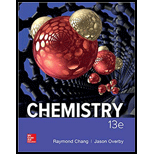
Concept explainers
- a)
Interpretation: The oxidation number of the metal ion for the given coordination compound to be predicted.
Concept Introduction:
Lewis acid: The species which accepts the lone pair of electrons.
Lewis base: The species which donates lone pair of electrons.
Donor atom: The neutral molecule or the negatively charged species which donates pair of electrons is known as Donor atom.
Coordinate covalent bonds: A covalent bond in which the Ligand donates both electrons to the metal ion to construct a bonding interaction known as coordinate covalent bond.
To Identify: The oxidation number of the metal ion for the given coordination compound to be predicted.
- b)
Interpretation: The oxidation number of the metal ion for the given coordination compound to be predicted.
Concept Introduction:
Lewis acid: The species which accepts the lone pair of electrons.
Lewis base: The species which donates lone pair of electrons.
Donor atom: The neutral molecule or the negatively charged species which donates pair of electrons is known as Donor atom.
Coordinate covalent bonds: A covalent bond in which the Ligand donates both electrons to the metal ion to construct a bonding interaction known as coordinate covalent bond.
To Identify: The oxidation number of the metal ion for the given coordination compound to be predicted.
- c)
Interpretation: The oxidation number of the metal ion for the given coordination compound to be predicted.
Concept Introduction:
Lewis acid: The species which accepts the lone pair of electrons.
Lewis base: The species which donates lone pair of electrons.
Donor atom: The neutral molecule or the negatively charged species which donates pair of electrons is known as Donor atom.
Coordinate covalent bonds: A covalent bond in which the Ligand donates both electrons to the metal ion to construct a bonding interaction known as coordinate covalent bond.
To Identify: The oxidation number of the metal ion for the given coordination compound to be predicted.
Trending nowThis is a popular solution!

Chapter 23 Solutions
CHEMISTRY (LL) W/CNCT >BI<
- in the scope of ontario SCH4U grade 12 course, please show ALL workarrow_forwardIs the chemical reaction CuCl42-(green) + 4H2O <==> Cu(H2O)42+(blue) + 4Cl- exothermic or endothermic?arrow_forwardIf we react tetraethoxypropane with hydrazine, what is the product obtained (explain its formula). State the reason why the corresponding dialdehyde is not used.arrow_forward
- drawing, no aiarrow_forwardIf CH3COCH2CH(OCH3)2 (4,4-dimethoxy-2-butanone) and hydrazine react, two isomeric products are formed. State their structure and which will be the majority.arrow_forward+ Reset Provide the correct IUPAC name for the compound shown here. 4-methylhept-2-ene (Z)- (E)- 1-6-5-2-3-4- cyclo iso tert- sec- di tri hept hex oct meth eth pent ane yne ene ylarrow_forward
 Chemistry: Principles and ReactionsChemistryISBN:9781305079373Author:William L. Masterton, Cecile N. HurleyPublisher:Cengage Learning
Chemistry: Principles and ReactionsChemistryISBN:9781305079373Author:William L. Masterton, Cecile N. HurleyPublisher:Cengage Learning Chemistry: The Molecular ScienceChemistryISBN:9781285199047Author:John W. Moore, Conrad L. StanitskiPublisher:Cengage Learning
Chemistry: The Molecular ScienceChemistryISBN:9781285199047Author:John W. Moore, Conrad L. StanitskiPublisher:Cengage Learning ChemistryChemistryISBN:9781305957404Author:Steven S. Zumdahl, Susan A. Zumdahl, Donald J. DeCostePublisher:Cengage Learning
ChemistryChemistryISBN:9781305957404Author:Steven S. Zumdahl, Susan A. Zumdahl, Donald J. DeCostePublisher:Cengage Learning Chemistry: An Atoms First ApproachChemistryISBN:9781305079243Author:Steven S. Zumdahl, Susan A. ZumdahlPublisher:Cengage Learning
Chemistry: An Atoms First ApproachChemistryISBN:9781305079243Author:Steven S. Zumdahl, Susan A. ZumdahlPublisher:Cengage Learning




